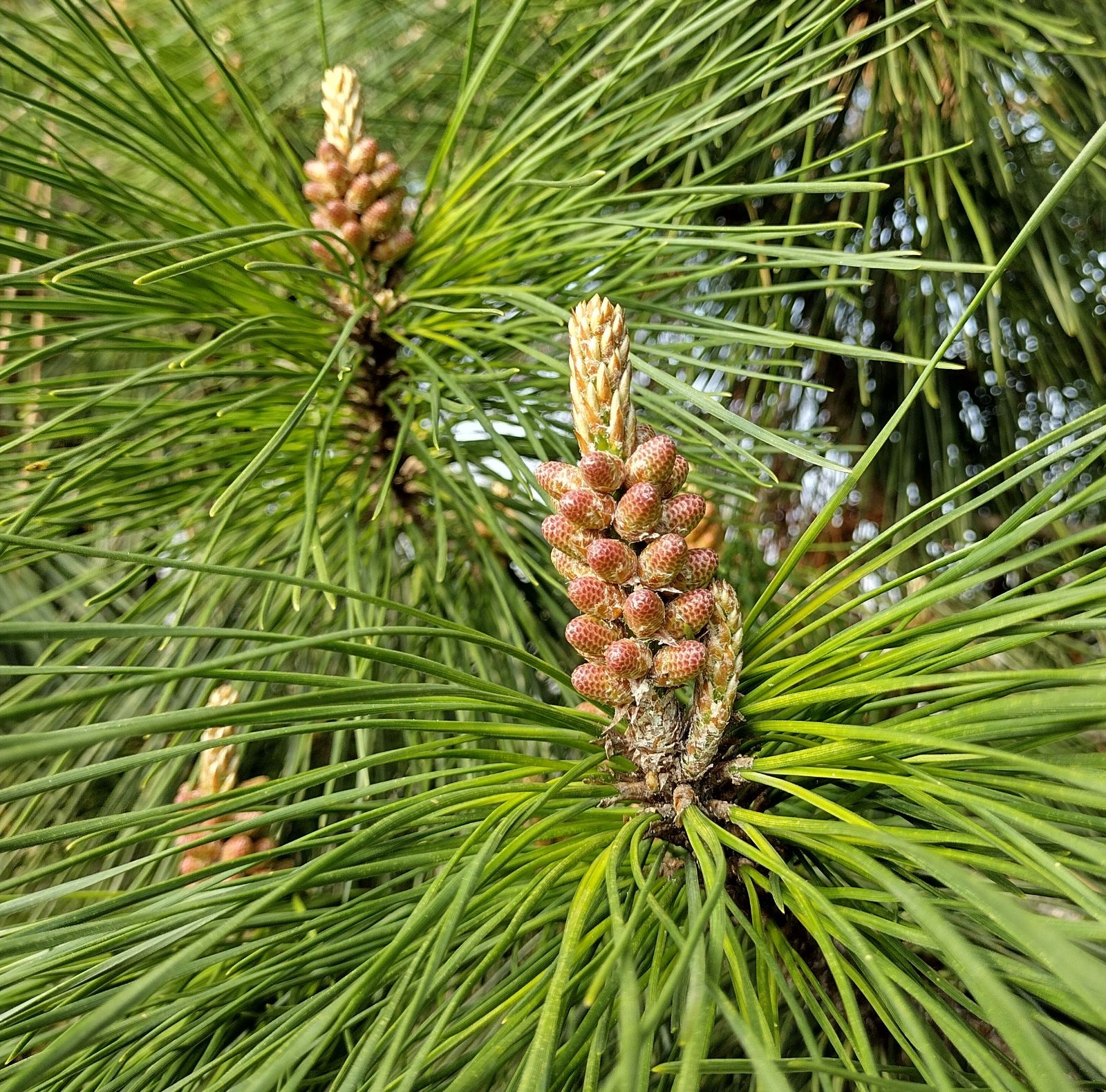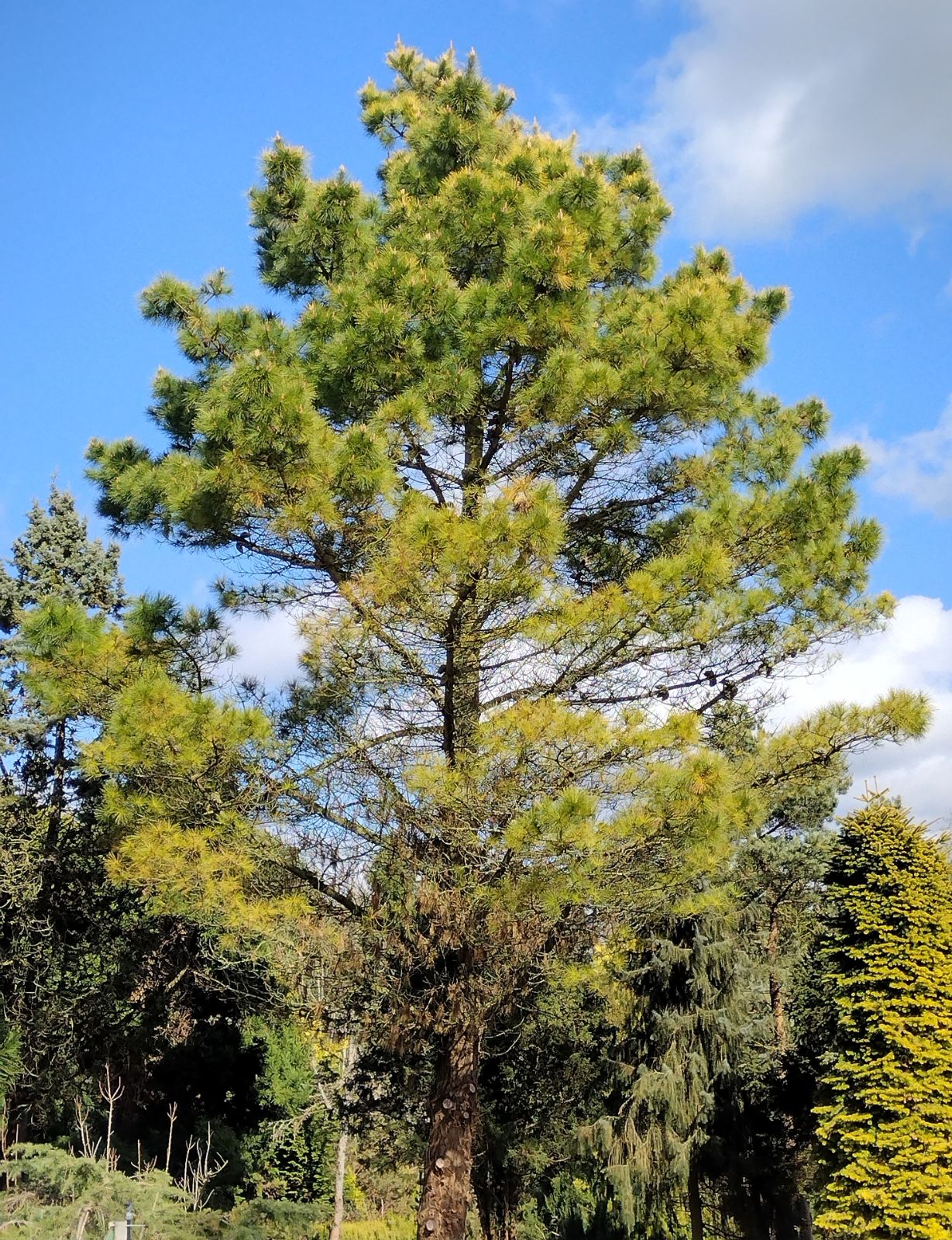Pinus radiata
Credits
Article from Bean's Trees and Shrubs Hardy in the British Isles
Recommended citation
'Pinus radiata' from the website Trees and Shrubs Online (treesandshrubsonline.
Infraspecifics
Other taxa in genus
- Pinus albicaulis
- Pinus arizonica
- Pinus armandii
- Pinus attenuata
- Pinus ayacahuite
- Pinus balfouriana
- Pinus banksiana
- Pinus bhutanica
- Pinus brutia
- Pinus bungeana
- Pinus canariensis
- Pinus cembra
- Pinus cembroides
- Pinus chiapensis
- Pinus contorta
- Pinus coulteri
- Pinus culminicola
- Pinus densata
- Pinus densiflora
- Pinus devoniana
- Pinus durangensis
- Pinus echinata
- Pinus edulis
- Pinus elliottii
- Pinus engelmannii
- Pinus eremitana
- Pinus flexilis
- Pinus gerardiana
- Pinus greggii
- Pinus × hakkodensis
- Pinus halepensis
- Pinus hartwegii
- Pinus heldreichii
- Pinus henryi
- Pinus × holfordiana
- Pinus hwangshanensis
- Pinus jeffreyi
- Pinus johannis
- Pinus koraiensis
- Pinus lambertiana
- Pinus leiophylla
- Pinus longaeva
- Pinus massoniana
- Pinus maximartinezii
- Pinus monophylla
- Pinus montezumae
- Pinus monticola
- Pinus morrisonicola
- Pinus mugo
- Pinus muricata
- Pinus nelsonii
- Pinus nigra
- Pinus oocarpa
- Pinus orizabensis
- Pinus palustris
- Pinus parviflora
- Pinus patula
- Pinus peuce
- Pinus pinaster
- Pinus pinceana
- Pinus pinea
- Pinus ponderosa
- Pinus pseudostrobus
- Pinus pumila
- Pinus pungens
- Pinus quadrifolia
- Pinus remota
- Pinus resinosa
- Pinus rigida
- Pinus roxburghii
- Pinus sabiniana
- Pinus serotina
- Pinus sibirica
- Pinus strobiformis
- Pinus strobus
- Pinus sylvestris
- Pinus tabuliformis
- Pinus taeda
- Pinus taiwanensis
- Pinus teocote
- Pinus thunbergii
- Pinus torreyana
- Pinus virginiana
- Pinus wallichiana
- Pinus wangii
- Pinus yunnanensis
A tree up to 115 ft high, with a trunk occasionally 6 ft thick; bark very rugged, dark brown; young shoots glabrous, yellowish brown; buds resinous, cylindrical. Leaves in threes, falling the third year, 2 to 5 in. long, soft and flexible, very dense on the branchlets, of a rich grassy green, convex on the outer face, faintly lined with stomata; margins minutely toothed; leaf-sheath persistent, 1⁄4 to 1⁄2 in. long. Cones obliquely conical, rich bright brown, 3 to 5 in. long, 2 to 3 in. wide near the base; shortly stalked and more or less deflexed, so that the inner side is close to the branch and is imperfectly developed; the boss of the scale is diamond-shaped, with a minute prickle in the centre. The cones are usually borne in whorls of two or three, and remain closed for years upon the branches.
Native of Monterey, California, where it is confined to a few hills near the sea; introduced in 1833 by Douglas. In maritime situations in the south and west of Britain this pine thrives splendidly, growing at the rate of 4 or 5 ft annually, and average rates of 3 ft a year have been attained by some trees in southern England and well inland. As an example, Elwes and Henry mentioned a tree at Whiteknights, Reading, which measured 52 × 4 ft when eighteen years old from seed. A more recent example, cited by A. F. Mitchell, is a tree at Albury Park, Surrey, which, twenty-eight years planted, is 79 ft high. Such rapid growth is perhaps exceptional, but the many thriving trees in Surrey, Sussex, and even farther east show that the Monterey pine is able to survive hard winters and grow vigorously well outside the Atlantic zone.
On the other hand, P. radiata is tender when young and, according to Loudon, most of the seedlings from the original introduction by Douglas were killed in the winter of 1837–8. And being a warmth-loving species, it is not suitable for areas where the summer is cooler than average. But the browning of the foliage in winter, mentioned in previous editions, is not really damaging and may occur even in fairly mild winters if there are prolonged periods of dry, cold winds. But it renders the tree very unsightly for a time. Salt-laden winds from the Atlantic it withstands very well, and it is much used as a windbreak in the milder parts.
There are many notable specimens of P. radiata in the British Isles; measurements of over sixty of these will be found in A. F. Mitchell’s Conifers in the British Isles. Of the trees listed by Elwes and Henry early this century nearly all survive. Among them are: Cuffnells, Lyndhurst, Hants, 140 × 121⁄4 ft (1961); Northerwood House, Hants, 116 × 18 ft (1963); Knowle Hotel, Sidmouth, Devon, 75 × 19 ft (1965); Haldon House, Devon, 94 × 191⁄4 ft (1967); Bodorgan, Anglesey, 70 × 24 ft at ground-level (1966). Some others, selected for size, or because they grow outside the optimum area, are: Sandling Park, Hythe, Kent, pl. 1848, 95 × 171⁄2 ft at 6 ft (1965); Dropmore, Bucks, pl. 1839, 90 × 171⁄4 ft (1970); Albury Park, Surrey, pl. 1926, 95 × 81⁄4 ft (1970); Bicton, Devon, 85 × 213⁄4 ft (1967).
Although of no importance as a forestry tree in Britain, P. radiata is an important source of timber in the southern hemisphere, where the plantations now vastly exceed in acreage the original wild stands. It is now being tried as a plantation tree in Britain, and a great increase in its use is likely.
From the Supplement (Vol. V)
Of the trees mentioned by Elwes and Henry early this century, only the following still exist: Cuffnells, Lyndhurst, Hants, 143 × 121⁄2 ft (1980); Northerwood House,’ Hants, 118 × 181⁄2 ft (1976); Heanton Satchville, Devon, 115 × 181⁄4 ft (1981).
Some other examples are: Dropmore, Bucks., pl. 1855, 85 × 121⁄2 ft (1982); Albury Park, Surrey, pl. 1926, 104 × 9 ft (1973); Sandling Park, Hythe, Kent, pl. 1948, 110 × 23 ft at 2 ft (1984); Heckfield Place, Hants, 111 × 201⁄4 ft (1982); Bicton, Devon, 98 × 213⁄4 ft (1977); Castle Horneck, Penzance, 98 × 21 ft (1979); Keir House, Perths., 111 × 161⁄2 ft (1985); Hillsborough, Co. Down, pl. 1872, 138 × 131⁄4 ft (1982); Ballywalter, Co. Down, 132 × 203⁄4 ft, a superb tree (1982).
Seedlings with more or less golden leaves occur occasionally. The cultivar-name ‘Aurea’ belongs properly to the clone descended from a tree found in New Zealand some years before 1910. For a later discovery see The Garden (Journ. R.H.S.), Vol. 107, p. 37 (1982).
'Aurea'
A selection of apparently unknown origin and perhaps illegitimately named (Auders & Spicer 2012), it has a golden glow to the foliage. Ultimate size is unknown, but potentially quite a large tree as the British Champion was measured at 14 m in 2017 (The Tree Register 2022).






